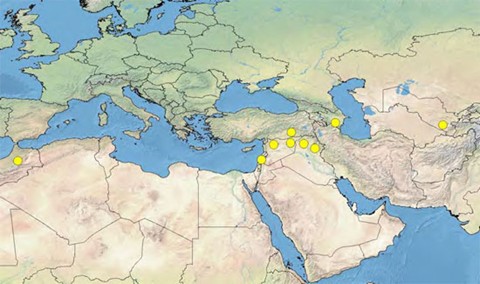
Having dedicated the better part of 2009 to understanding the threat posed by Ug99, a fungus that threatens to decimate much of the Eastern Hemisphere’s wheat crop, our ears always prick up when we hear of looming agricultural catastrophes. The latest comes in the form of Pathogen206, which afflicts wheat with yellow rust (aka stripe rust). Like Ug99, the emerging pathogen overcomes one of mankind’s key genetic defenses—a gene in which we seemingly placed far too much trust:
Following the epidemics associated with the development of virulence for Yr9, stripe rust susceptible cultivars were in most cases replaced. Unfortunately the resistance of many of the replacement cultivars, including the mega-cultivars PBW343, Inquilab-91, Chamran, Shiroudi, Kubsa, and Imam, was based on the single major gene Yr27 only. These cultivars represent the same genetic material (Atilla) released under different names in respective countries.
The breakdown of Yr27 was first reported in South Asia between 2002-2004, with mega-cultivars like PBW343 and Inquilab-91 in India and Pakistan showing susceptibility to the new Yr27 virulent pathotype(s). Replacement of these cultivars is underway (e.g, Inquilab-91 in Pakistan is being replaced by new resistant cultivars like Seher-06). Unfavourable environmental conditions presumably restricted the increase in frequency and distribution of pathotypes within the Yr27 lineage until 2009, when favourable conditions resulted in serious outbreaks of stripe rust in several countries e.g., Morocco, Uzbekistan, Turkey, Azerbaijan, Algeria and Afghanistan. Virulence for Yr27 was confirmed in many of the 2009 outbreaks.
Climactic conditions are currently ideal for a widespread epidemic, which could take out much of the Middle East’s wheat in just two weeks. (The current 2010 spread is shown in the map above.) The good news is that there are proven alternatives to the Yr27 wheat that has been breached; the bad news, per the usual, is that getting this wheat planted requires cooperation from dysfunctional national governments. Color us a deep shade of pessimistic on this one.


Jordan // May 12, 2010 at 12:49 pm
That is one of the eternal dilemmas of selective breeding. By selecting for a particular set of traits, you’re going to drag along other linked genes, which is going to reduce the overall diversity of your product. To a degree that’s why hybrids can end up working really well: if you can keep the genes you want while swapping out the bad ones, the results can be really good. But unless you can generate a whole mess of hybrids that work equally well, you’re still going to be using a small handful of very similar cultivars.
In theory there are genetic engineering techniques that might allow you to generate artificial diversity, but that tends to go against the business ethos of creating standardized products. Hence why I tend to think that we need to be shoveling a lot more money into seed banks and other repositories of genetic information. You never know when you’re going to have to dip back into the pool because what seems useless today might be vitally important tomorrow.
Brendan I. Koerner // May 12, 2010 at 2:23 pm
@Jordan: I think this nails the problem:
“…that tends to go against the business ethos of creating standardized products.”
Yeah, exactly. Once there’s a successful gene, everyone wants to plant it ASAP, with no regard for the consequences of monoculture (not to mention the downsides of major-gene reliance). The assumption is that if/when a new strain of the pathogen arises, a new gene will be developed to counter it. But that’s a huge gamble.
antimeria - a complete impediment to understanding // May 13, 2010 at 9:10 am
[…] aka Brendan Koerner, reminds us of a decidedly unglamorous disaster that wouldn’t take long to play out: Having dedicated the better part of 2009 to […]
Ominous warning signs for Big Agra, food supplies « eats shoots 'n leaves // May 18, 2010 at 11:56 am
[…] I. Koerner, who blogs at Microkhan, has been reporting on grave dangers confronting a world in which monoculture has become the rule. Having dedicated the […]
Monoculture, Monsanto, and the threat of famine « eats shoots 'n leaves // May 30, 2010 at 10:35 am
[…] I. Koerner, who blogs at Microkhan , has been reporting on grave dangers confronting a world in which monoculture has become the rule. Having dedicated the better part of […]